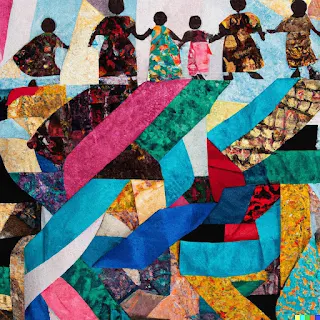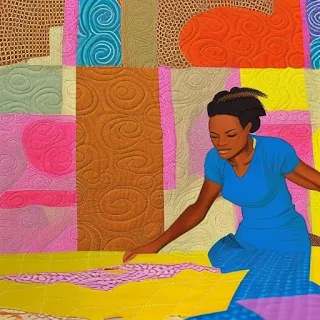History of Quiltmaking in Liberia
Quilting in Liberia holds profound historical, cultural, and symbolic significance, representing freedom, resilience, and identity for former slaves and their descendants. Quilts serve not only as practical objects but also as intricate works of art, storytelling tools, and symbols of heritage. Through quilting, Liberians preserve their African traditions, share their histories, and celebrate their connections to community and liberty. Use this article as a source of inspiration for your own creative quilting projects whether it's recreating traditional Liberian patterns or developing new designs.
Threads of Freedom: The Cultural, Historical, and Symbolic Power of Quilting in Liberia
In Liberia, quilting holds a special meaning. It represents freedom and liberty, and the beautiful and meaningful quilts reflect the history and identity of the people who make them. Liberians preserve and celebrate African heritage and culture through quilting, making it a powerful symbol of their identity and strength. The significance of quilting in the lives of former Liberian slaves resonates as a testament to the enduring power of art, resilience, and cultural heritage in the face of historical injustice.
Three Fascinating Stories of Quiltmaking for VIPs in Liberia.
In Liberia, people, especially women, first expressed themselves through quilting. Former slaves in Liberia combined quilt patterns and hand sewing as a path to freedom. Oral history has been around longer than written history. Quilts served as a story, clothing, bedding, window and door coverings, and freedom for African slaves.
Fabric is lifeless, but in the hands of former slaves from Liberia, quilting became a symbol of freedom and liberty. Quilts in Liberia are often used as gifts for special occasions, such as weddings, births, graduations, and diplomatic visits. These tapestries are not your usual quilts, which are handcrafted affectionately by your grandmother and kept on your bed or in your cedar closet. Instead, they are detailed and complex pieces of art.
Martha Ann Erskine Ricks, a former Liberian slave, met Queen Victoria and presented her with a beautiful quilt she had spent half of a century quilting.
The American Colonization Society (ACS) was founded in 1816 by Robert Finley and other prominent white Americans to promote the migration of free blacks and freed slaves to Africa. The society believed that free blacks could not integrate into U.S. society and that their presence would threaten the institution of slavery. The organization received funding from the federal government and some state legislatures, as well as from churches and private donors.
The society's first ship, the Elizabeth, departed from New York on February 6, 1820, carrying 88 black emigrants and three white agents to West Africa. After a failed attempt to settle on Sherbro Island, the society acquired a piece of land on Cape Mesurado, where they founded the colony of Liberia in 1822.
Americo-Liberian quilter and farmer Martha Ann Erskine Ricks was born a slave in Tennessee in 1817, but her father bought their freedom and moved them to Liberia in 1830 through the ACS. The cost of sailing from the U.S. to Liberia in 1820 was about $50 per person, equivalent to about $1,200 in 2023.
Over 50 years, she dedicated her efforts to creating a stunning quilt that showcased a blossoming Liberian coffee tree made from satin ribbons and random pieces of fabric. She carefully crafted the piece using cotton silk from a nearby tree and cotton, creating a beautiful piece of art from natural materials. from raw materials.
This act of creating a quilt over a lifetime is a powerful example of the devotion embedded in the craft, a theme explored in our article, The Sacred Stitch: Finding Prayer and Purpose in the Quilting Traditions of Liberia and Sierra Leone. For Ricks and many others, quilting was far more than a hobby; it was a profound act of patience, prayer, and cultural expression.
Mrs. Ricks, in 1892, at 76 years old, began her unofficial journey to see Queen Victoria. She traveled in the company of the wife of the ex-president of Liberia, Jane Waring Roberts. When Mrs. Ricks arrived in England, Presbyterian minister Edward Wilmot Blyden wrote to Sir Henry Ponsonby, Private Secretary to Queen Victoria, telling him of the arrival in England of Mrs. Ricks and her wish to meet the Queen. Sir Henry Ponsonby replied, proposing an unofficial visit since the necessity of applying for an official visit through the Foreign Office would take time and a telegram.
Queen Victoria hosted Mrs. Ricks at the palace during a luncheon with her children, grandchildren, and dignitaries such as Lord and Lordess Mayor, Princess Louise, Princess Beatrice, Prince and Princess of Wales, and Princess Victoria and Maud.
The Queen reportedly told Mrs. Ricks, "I am honored by all the trouble you took to meet me and present me with this beautiful quilt." The Queen was deeply moved by the quilt and the fascinating story behind it, which she noted in her diary. Queen Victoria, during her reign, had a passion for fiber arts, finding joy and relaxation in the art of knitting and crocheting.
The story of Martha Ann Erskine Ricks is a landmark example of how quilting has been part of the fight for freedom and a tool for diplomatic expression throughout Liberian history, symbolizing liberty, resilience, and the pursuit of recognition on the world stage.
Of course! Here is the revised text with the link integrated naturally to provide deeper context for the reader. ---During her visit to TD Jakes's popular mega-church in Dallas, Texas, former President of Liberia Ellen Johnson Sirleaf gifted him with a handmade quilt.
President John F. Kennedy was gifted with a beautiful Liberian Quilt.
Quilting held deep meaning for former Liberian slaves.
How to Make a Liberian-Inspired Cotton Quilt for Your Beloved Pet
You can find free patterns online or create your own design. A baby quilt size, typically 36 by 54 inches, is ideal for most pets. Consider using bold geometric shapes, a hallmark of many African textile arts. As explored in "The Power of Shapes in Conveying Emotion," the patterns you choose can communicate love, protection, and joy.
Look for high-quality quilting cotton for the quilt top and backing. You will also need batting—the insulating layer between the top and back that provides warmth and thickness. For a soft and fluffy quilt, extra loft 100% polyester batting is an excellent choice.
You will need to cut squares, rectangles, or other shapes depending on your design. Using a rotary cutter and a cutting mat will ensure accuracy and speed.
Sew the fabric pieces together using a 1/4-inch seam allowance. Press the seams open or to one side with an iron. You can use pins or clips to hold the pieces together as you sew.
Lay the quilt back on a large flat surface, right side down. Smooth out any wrinkles and tape the edges to the surface. Place the batting on top of the quilt back and smooth it out. Then, place the quilt top on the batting, right side up. Ensure all layers are aligned and smooth.
You can use a sewing machine or hand-stitch to quilt your project. Quilting is the process of sewing through all the layers to hold them together and create a decorative pattern. You can follow the lines of your pieced design or create your own quilting motif.
After quilting, trim the excess fabric and batting around the edges with scissors or a rotary cutter. Then, make and attach the binding—a strip of fabric that covers the raw edges and gives your quilt a finished, durable look.








